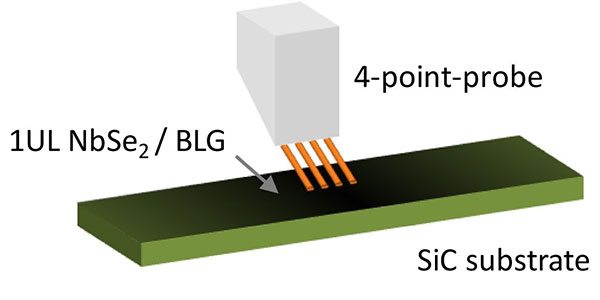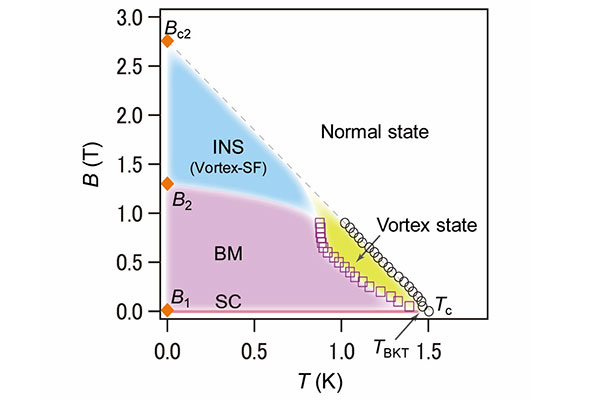Applying large enough magnetic fields usually results in the disruption of superconducting states in materials, even at drastically low temperatures. This thereby changes them directly into insulators - or so was generally thought. Now, scientists from the Tokyo Institute of Technology, The University of Tokyo and Tohoku University have discovered the interesting occurrence of multi-state transitions of these superconductors - going from superconductor, to special metal, and then to insulator.

Figure1: Electrical transport measurements ⒸPhysical Review B
Because of their absolute-zero electrical resistance and/or their amazing ability to completely expel external magnetic fields, superconductors have attracted much attention. This is from the point of view from both fundamental physics and their application. One such example is a superconducting coil in a magnetic field. Superconductivity is well understood in terms of the establishment of highly-ordered coherence among electrons in materials, where two electrons are bounded with each other to make a pair and flow collectively in material without collision (resistance). This process, of course, does not suffer from energy dissipation. However, when a magnetic field is applied on the superconducting material, the paired electrons are no longer able to maintain their coherent relationship and as a result the superconducting state is broken. At a given temperature, the highest magnetic field under which a material remains superconducting is defined as the critical field.
This phenomenon has been intensively studied under the framework of phase transition. When the change is abrupt like in the case of melting ice, it is called the first-order transition. In contrast, when the transition takes place in a gradual and continuous manner, it is called the second-order transition. Studying the transition path of superconductors under a magnetic field yields insights into the quantum processes involved. Furthermore, it enables us to design smarter superconducting materials and devices for advanced technologies.
Two-dimensional superconductors (2DSCs) such as mono layer NbSe2 are the best candidates to study this type of phase transitions. The very thin nature of material constrains the electrons inside to form a pair with a limited number of electrons, so that the smallest perturbation can set the phase transition. Furthermore, 2DSC has a high potential for applications to small-scale electronics.
In 2DSCs, when we apply a magnetic field beyond the critical value, the material enters into a fuzzy state, where the magnetic field penetrates the material, but the resistance still remains minimal. Upon further increasing the magnetic field, the superconductivity is finally destroyed. The material changes into an ordinary insulator. This is known as the superconductor-to-insulator phase transition. Because this phenomenon is observed at very low temperatures, the quantum fluctuations in the material become comparable to or even larger than the classical thermal fluctuations. Therefore, this is called a "quantum" phase transition.
To understand the path-phase transition as well as the fuzzy or mixed state in ultrathin NbSe2, the present research team measured the magnetoresistance of material (see Fig. 1). In other words, the response of electrical resistivity under an external magnetic field. Prof. Ichinokura explains, "As shown in Fig.2, we estimated the critical magnetic field at the respective quantum phase boundaries in mono-layer NbSe2 by the four-point-probe method". In fact, they found that when a small magnetic field is applied to the sample, the coherent flow of electrons is broken, but the electron pairs still remain. This indicates that the vortices still move even under the magnetic field and create a finite resistance. This peculiar (fuzzy) state which exhibits the observed minimal resistance is called the Bose metal state, where electron pairs do exist in material, but the coherence among them is lost. Upon further increase in the magnetic field, the material transitioned to an insulating state. The team also found that the transition between the normal and superconducting states around the critical temperature was driven by quantum fluctuations, reflecting a similar multi-transition pathway. Excited by the results, Prof. Ichinokura commented, "The scaling analysis based on the model of the Bose metal explains well the two-step transition, suggesting the existence of a bosonic ground state."

Figure 2. Superconductivity-related states Ⓒ Physical Review B
This study bolsters the theoretical claims of multi-phase transitions in superconductors and pushes the research frontier forward. The current research focused on transition path vis-a-vis investigating the fluctuating vortices; where will peeping into the vortex take us from here? Only science will tell!
- Publication Details:
Authors: Satoru Ichinokura*,Yuki Nakata, Katsuaki Sugawara, Yukihiro Endo, Akari Takayama, Takashi Takahashi, and Shuji Hasegawa
Title: Vortex-induced quantum metallicity in the mono-unit-layer superconductor NbSe2
Journal: Physical Review B
DOI: 10.1103/PhysRevB.99.220501
Contact:
Katsuaki Sugawara
WPI-AIMR,
Tohoku University
Email: k.sugawara arpes.phys.tohoku.ac.jp
arpes.phys.tohoku.ac.jp
Satoru Ichinokura
Department of Physics,
The University of Tokyo
Email: ichinokura phys.titech.ac.jp
phys.titech.ac.jp

